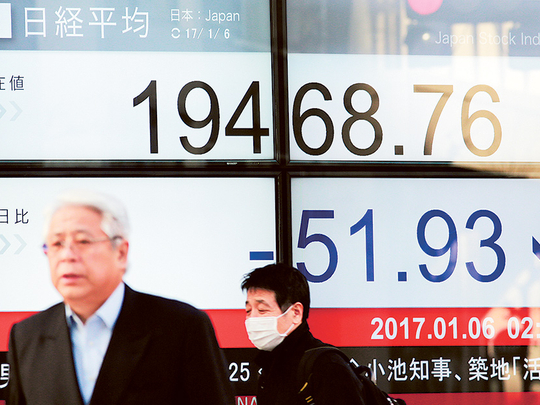
London: World stocks held near one-and-a-half year highs and the dollar moved up from a three-week low on Friday, with investors looking ahead to US jobs data to provide clues on the pace of US interest rate rises this year.
MSCI’s gauge of the world’s stock markets hit its highest since July 2015, taking its gains so far this year to 1.7 per cent, helped by this week’s generally upbeat economic readings in the US, China and Europe.
Asian shares recovered to four-week highs, while the pan-European STOXX 600 dipped 0.3 per cent, just 0.7 per cent off a 1-year high hit this week.
Wall Street futures indicated a flat open ahead of the release of US jobs data due out at 13.30 GMT.
A Reuters survey of economists signalled that US employers were likely to have maintained a solid pace of hiring in December while raising wages, putting the economy on a path to stronger growth and further interest rate increases this year.
Non-farm payrolls probably increased by 178,000 jobs last month, the survey showed.
Federal Reserve minutes from December released this week showed that almost all Fed policymakers thought the economy could grow more quickly because of fiscal stimulus and many were eyeing faster interest rate rises than previously expected.
Despite this, investors have scaled back expectations for the number of rate rises this year since December, and the dollar is down from this week’s 14-year high.
The currency slumped 1.6 per cent on Thursday to a three-week low of 115.04 yen, its biggest fall for five months. It bounced back 0.5 per cent on Friday to 115.93 yen.
Weaker-than-expected private-sector ADP payrolls data on Thursday contributed to the dip in the dollar, despite other strong US data. Investors were looking to today’s jobs figures to see if the bounceback for the dollar could be sustained.
“It’s likely that a stronger jobs number will, in the shorter term, strengthen the dollar. But [soon] people will start questioning how much of a strong dollar the Fed can stomach,” ETF Securities’ head of research and investment strategy, James Butterfill, said.
“Given the sell-off in the dollar, there could be appreciation over the next few weeks, but in the coming few months we could see further dollar weakness.”
The dollar’s index against a basket of six major currencies was up 0.1 per cent at 101.640, down more than 2 per cent from Tuesday’s 14-year high of 103.82.
The dollar bounced back slightly against the yuan, which gave up some of the massive gains made in the previous two days despite Friday’s strong midpoint fixing by China’s central bank.
The recent surge in the dollar and its borrowing costs sparked by Donald Trump’s election victory has eased, with the US 10-year yield slipping to one-month lows.
Trump’s victory had sparked a major realignment in markets.
Expectations that his administration will bring tax cuts, higher spending and deregulation have boosted US bond yields and the dollar, to the detriment of many emerging economies that have benefited from cheap dollar funding and had attracted trillions of dollars from investors shunning low US yields.
While US yields have slipped, concerns over rising inflation were prevalent in the Eurozone, where government bond yields were set to end the first trading week of the year with their biggest weekly rise for at least a month.
The Euro edged down 0.1 per cent to $1.0591 having posted its biggest gain for 7 months in the previous session.
The retreat in US bond yields has supported gold this week, and bullion was up 2.3 per cent for the week, set for its biggest weekly gain in two months, but down 0.2 per cent on the day ahead of the US data.
That weighed on Britain’s commodity-heavy FTSE 100, which lingered below record highs.
Having closed 2016 at an all-time high, the British blue-chip index has hit two new record peaks this week already, but was last down 0.1 per cent.
Oil prices were steady as Saudi Arabia and Abu Dhabi started promised supply cuts, but doubts that all producers will implement output reductions agreed in a landmark Opec deal last year kept markets from rising further.
International benchmark Brent crude futures traded up 0.2 per cent at $56.97 per barrel.












